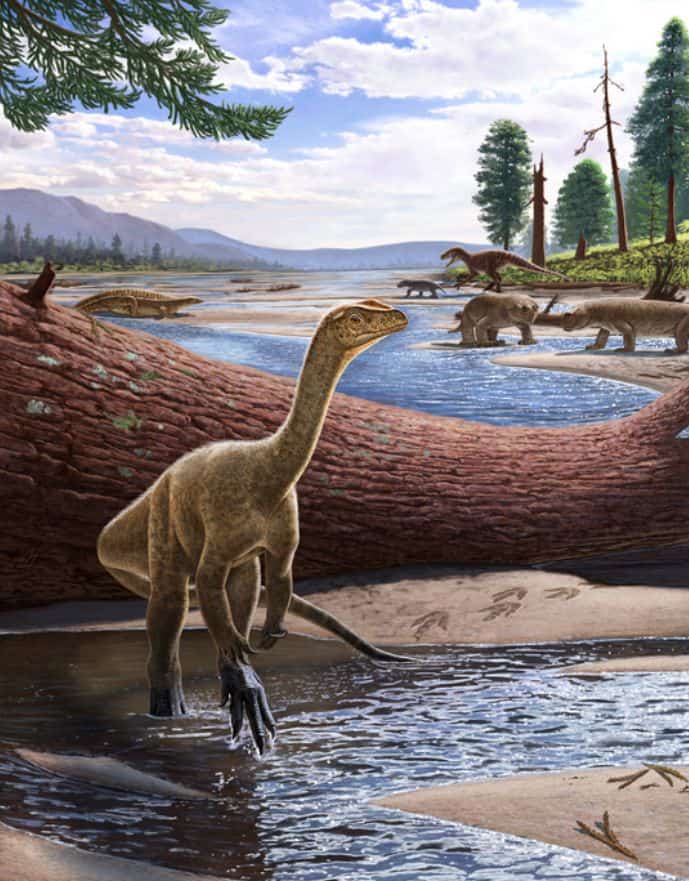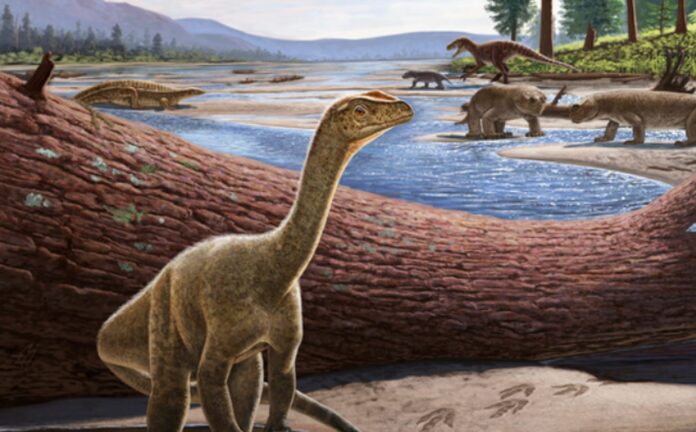A new, early dinosaur has been found and named by an international team of paleontologists under the direction of Virginia Tech. The skeleton was discovered in 2017 and 2019 by a graduate student in the Virginia Tech Department of Geosciences and other paleontologists during the course of two digs.
The research on the newly discovered long-necked sauropodomorph, Mbiresaurus raathi, was published in the journal Nature today. The skeleton is the oldest dinosaur skeleton that has so far been discovered in Africa. The animal had a long tail and was thought to have been 6 feet long. It could have weighted 20 to 65 pounds. The skeleton was discovered in northern Zimbabwe, missing only pieces of the skull and hands.
Christopher Griffin from the Virginia Tech College of Science says that the discovery of Mbiresaurus raathi “fills in a critical geographic gap in the fossil record of the oldest dinosaurs and shows the power of hypothesis-driven fieldwork for testing predictions about the ancient past.”
The oldest dinosaurs discovered anywhere in the globe are about equal in age to those found in Africa, according to Griffin. The earliest known dinosaurs, dating from the Carnian Stage of the Late Triassic period around 230 million years ago, are extremely rare and have only been discovered in a small number of locations worldwide, namely northern Argentina, southern Brazil, and India.
Early dinosaurs like Mbiresaurus raathi demonstrate that the early evolution of dinosaurs is still being written with each new discovery and that their emergence was far more intricate than previously thought, according to Sterling Nesbitt, another author of the paper.

Finding fossils such as Mbiresaurus raathi
A variety of Carnian-aged fossils, including a herrerasaurid dinosaur, early mammal relatives like cynodonts, armored crocodylian relatives like aetosaurs, and, according to Griffin’s description, “bizarre, archaic reptiles” known as rhynchosaurs, which are typically found in South America and India from this same time period, were discovered alongside Mbiresaurus.
(Mbiresaurus derives from ancient Greek and Shona roots. The place where the animal was discovered is called “Mbire,” which is also the name of a former Shona dynasty that dominated the area. Michael Raath, a paleontologist who discovered fossils in northern Zimbabwe, is honored by the term “raathi.”
According to their discoveries, Mbiresaurus stood on two legs and had a small head compared to other dinosaur relatives. It had tiny, triangular-shaped teeth that were serrated, indicating that it was a herbivore or possibly an omnivore.
“We never expected to find such a complete and well-preserved dinosaur skeleton,” said Griffin, now a post-doctorate researcher at Yale University. “When I found the femur of Mbiresaurus, I immediately recognized it as belonging to a dinosaur and I knew I was holding the oldest dinosaur ever found in Africa. When I kept digging and found the left hip bone right next to the left thigh bone, I had to stop and take a breath — I knew that a lot of the skeleton was probably there, still articulated together in life position.”
A dinosaur dispersal theory
In addition to Mbiresaurus, the team of experts has developed a novel theory on dinosaur migration, including when and where it occurred.
All the continents, including Africa, were formerly a part of the supercontinent known as Pangea. Strong humid and arid latitudinal bands, with more temperate belts spanning higher latitudes and harsh deserts throughout the lower tropics of Pangea, are thought to have split the continent’s climate. According to Griffin, scientists had previously thought that these climate belts affected and limited the spread of animals across Pangea.
“Because dinosaurs initially dispersed under this climatic pattern, the early dispersal of dinosaurs should therefore have been controlled by latitude,” Griffin added. “The oldest dinosaurs are known from roughly the same ancient latitudes along the southern temperate climate belt what was at the time, approximately 50 degrees south.”
Griffin and colleagues from Virginia Tech’s Paleobiology and Geobiology Research Group specifically targeted northern Zimbabwe because it was located along the same climate zone that, during the Late Triassic Age, connected southern Brazil and India.
Furthermore, these earliest dinosaurs were confined by climatic bands to southern Pangea and did not become widely distributed until much later in their evolution. The research team created a novel data approach to examine this concept of climatic dispersal barriers based on prehistoric geography and the dinosaur family tree to support this assertion. The collapse of these barriers and a wave of northward distribution happened at the same time as the Carnian Pluvial Event, a time of extreme global humidity.
Barriers then appeared once more, tying the now-globalized dinosaurs to certain areas across Pangea for the rest of the Triassic Period, according to the research team. Griffin explained that the study’s “two-pronged approach” combines statistical approaches with hypothesis-driven predictive fieldwork to “independently support the hypothesis that the earliest dinosaurs were restricted by climate to just a few areas of the globe.”
Brenen Wynd, who also holds a doctorate from the Department of Geosciences, contributed to the development of the data model. “The early history of dinosaurs was a critical group for this kind of problem. Not only do we have a multitude of physical data from fossils, but also geochemical data that previously gave a really good idea of when major deserts were present,” he said. “This is the first time where those geochemical and fossil data have been supported using only evolutionary history and the relationships between different dinosaur species, which is very exciting.”
A blessing for paleontology in Zimbabwe as well as at Virginia Tech
The discovery of one of the earliest dinosaurs ever discovered, with the most of it intact, is a significant accomplishment for the Natural History Museum of Zimbabwe. Michel Zondo, a curator and fossil preparer at the museum, described the finding of the Mbiresaurus as “an exciting and special find for Zimbabwe and the entire paleontological field.
“The fact that the Mbiresaurus skeleton is almost complete, makes it a perfect reference material for further finds. It is the first sauropodomorph find of its size from Zimbabwe, otherwise most of our sauropodomorph finds from here are usually of medium- to large-sized animals.”
Darlington Munyikwa, the deputy executive director of the National Museums and Monuments of Zimbabwe, said, “The unfolding fossil assemblage from the Pebbly Arkose Formation in the Cabora Bassa Basin, which was hitherto known for paucity of animal fossils, is exciting. A number of fossil sites [are] waiting for future exploration were recorded, highlighting the potential of the area to add more valuable scientific material.”.
While the skeleton is being cleaned and researched, a large portion of the Mbiresaurus specimen is being preserved in Derring Hall at Virginia Tech. The Natural History Museum of Zimbabwe in Bulawayo, Zimbabwe, will maintain ownership of the entire Mbiresaurus skeleton as well as the extra fossils that were discovered.
The director of the museum, Moira Fitzpatrick, remarked, “This is such an exciting and important dinosaur find for Zimbabwe, and we have been watching the scientific process unfold with great pride.” She wasn’t a part of the investigation. “It has been a pleasure to work with Dr. Griffin,and we hope the relationship will continue well into the future.”
Another accomplishment for the Paleobiology and Geobiology Research Group is the discovery of Mbiresaurus. Nesbitt published an article in 2019 that described the newly discovered tyrannosauroid dinosaur Suskityrannus hazelae. Surprisingly, Nesbitt found the fossil in 1998 while participating in a dig excursion in New Mexico as a 16-year-old high school student.
Image Credit: Getty
You were reading: New Discovery Holds Evidence Of Africa’s Oldest Known Long-necked Dinosaur
